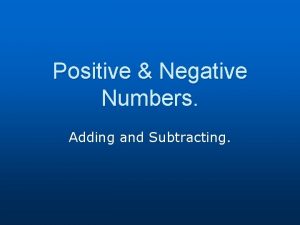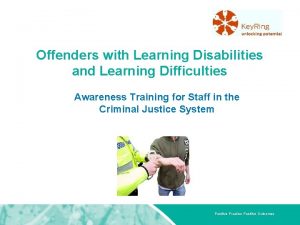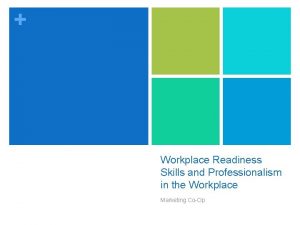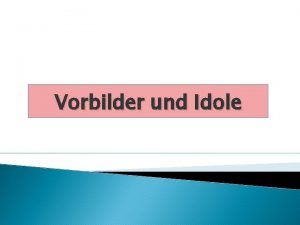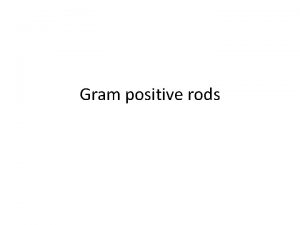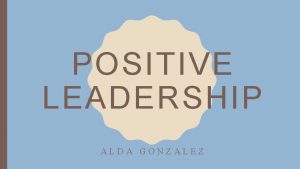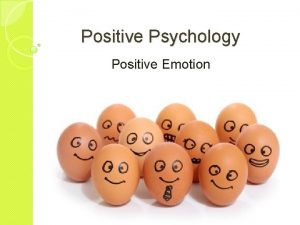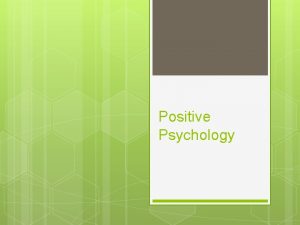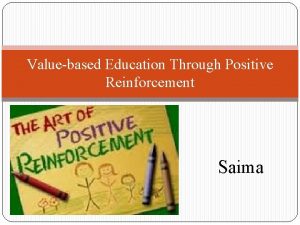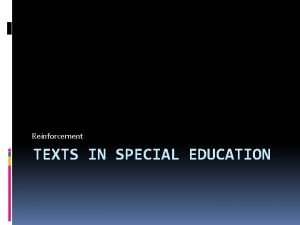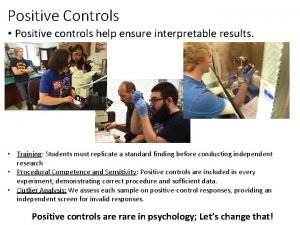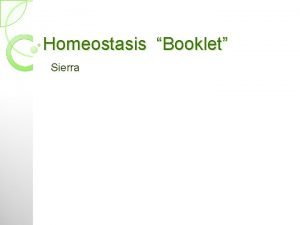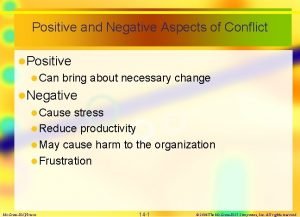positive education What is positive education Positive education















- Slides: 15

positive education

What is positive education? “Positive education is defined as education for both traditional skills and for happiness. The high prevalence worldwide of depression among young people, the small rise in life satisfaction, and the synergy between learning and positive emotion all argue that the skills for happiness should be taught in school. There is substantial evidence from well controlled studies that skills that increase resilience, positive emotion, engagement and meaning can be taught to schoolchildren. ”

Teaching Well-Being in Schools Question 1: in one or two words, what do you most want for your children? If you are like thousands of parents I’ve polled you responded, “Happiness, ” “Confidence, ” “Contentment, ” “Fulfillment, ” “Balance, ” “Good stuff, ” “Kindness, ” “Health, ” “Satisfaction, ” “Love, ” “Being civilized, ” “Meaning, ” and the like. In short, well being is your topmost priority for your children. Question 2: in one or two words, what do schools teach? If you are like other parents, you responded, “Achievement, ” “Thinking skills, ” “Success, ” “Conformity, ” “Literacy, ” “Math, ” “Work, ” “Test taking, ” “Discipline, ” and the like. In short, what schools teach is how to succeed in the workplace.

Two good reasons that well being should be taught in schools are the current flood of depression and the nominal increase in happiness over the last two generations. A third good reason is that greater well being enhances learning, the traditional goal of education. Positive mood produces broader attention, more creative thinking, and more holistic thinking. This, in contrast to negative mood, which produces narrowed attention, more critical thinking, and more analytic thinking. When you’re in a bad mood, you’re better at “what’s wrong here? ” When you’re in a good mood, you’re better at “what’s right here? ” Even worse: when you are in a bad mood, you fall back defensively on what you already know, and you follow orders well. Both positive and negative ways of thinking are important in the right situation, but all too often schools emphasize critical thinking and following orders rather than creative thinking and learning new stuff.

Can well-being be taught in schools? well being programs, like any medical intervention, must be evidence based, so we have tested two different programs for schools: the Penn Resiliency Program (PRP), and the Strath Haven Positive Psychology Curriculum. The Penn Resiliency Program : an experiment Goal : to increase students’ ability to handle day to day problems that are common during adolescence.

PRP promotes optimism by teaching students to think more realistically and flexibly about the problems they encounter. PRP also teaches assertiveness, creative brainstorming, decision making, relaxation, and several other coping skills. PRP is the most widely researched depression prevention program in the world. During the past two decades, twenty one studies have evaluated PRP in comparison to control groups. Many of these studies used randomized controlled designs. Together these studies include more than three thousand children and adolescents between the ages of eight and twenty two.

Here are the basic findings: • Penn Resiliency Program reduces and prevents symptoms of depression. • Penn Resiliency Program reduces hopelessness. The meta analysis also found that PRP significantly reduced hopelessness, increased optimism, and increased well being. • Penn Resiliency Program prevents clinical levels of depression and anxiety. • Penn Resiliency Program reduces and prevents anxiety.

• Penn Resiliency Program reduces conduct problems. • PRP works equally well for children of different racial/ethnic backgrounds. • Penn Resiliency Program improves health related behaviors, with young adults who complete the program having fewer symptoms of physical illness, fewer illness doctor visits, better diet and more exercise. • Training and supervision of group leaders is critical. • The fidelity of curriculum delivery is critical.

The Strath Haven Positive Psychology Curriculum The major goals of this global program are (1) to help students identify their signature character strengths and (2) to increase their using these strengths in their daily lives. In addition to these goals, the intervention strives to promote resilience, positive emotion, meaning and purpose, and positive social relationships. The curriculum con sists of more than twenty eighty minute sessions delivered over the ninth grade year. These involve discussing character strengths and the other positive psychology concepts and skills, a weekly in class activ ity, real world homework in which students apply these skills in their own lives, and journal reflections.

Here are two examples of the exercises we use in the curriculum: Three-Good-Things Exercise We instruct the students to write down daily three good things that happened each day for a week. The three things can be small in importance (“I answered a really hard question right in language arts today”) or big (“The guy I’ve liked for months asked me out!!!”). Next to each positive event, they write about one of the following: “Why did this good thing happen? ” “What does this mean to you? ” “How can you have more of this good thing in the future? ” Using Signature Strengths in New Ways Honesty. Loyalty. Perseverance. Creativity. Kindness. Wisdom. Courage. Fairness. These and sixteen other character strengths are valued in every culture in the world. We believe that you can get more satisfaction out of life if you identify which of these character strengths you have in abundance and then use them as much as possible in school, in hobbies, and with friends and family.

Here are the basic findings of the positive psychology program U. S. Department of Education program at Strath Haven: Engagement in learning, enjoyment of school, and achievement The positive psychology program improved the strengths of curiosity, love of learning, and creativitythem. Social skills and conduct problems The positive psychology program improved social skills (empathy, cooperation, assertiveness, self control), according to both mothers’ and “blind” teachers’ reports. The program reduced bad conduct, according to mothers’ reports.

“Teaching it, ” “Embedding it, ” and “Living it. ” Teaching It: Stand alone courses and course units are psychology: resilience, gratitude, strengths, meaning, flow, positive relationships, and positive emotion. Embedding It: Geelong Grammar teachers embed positive education into academic courses, on the sports field, in pastoral counseling, in music, and in the chapel. For example: English teachers use signature strengths and resiliency to discuss novels; Religion teachers ask students about the relationship between ethics and pleasure; Music teachers use resilience skills to build optimism from performances that did not go well. Athletic coaches teach the skill of “letting go of grudges” against teammates who perform poorly. Chapel is another locus of positive education. Scriptural passages on courage, forgiveness, persistence, and nearly every other strength are referenced during the daily services, reinforcing current classroom discussions.

Living It: Like all Geelong Grammar six year olds, Kevin starts his day in a semicircle with his uniformed first grade classmates. Facing his teacher, Kevin’s hand shoots up when the class is asked, “Children, what went well last night? ” Eager to answer, several first graders share brief anecdotes such as “We had my favorite last night: spaghetti” and “I played checkers with my older brother, and I won. ” Kevin says, “My sister and I cleaned the patio after dinner, and Mum hugged us after we finished. ” The teacher follows up with Kevin. “Why is it important to share what went well? ” He doesn’t hesitate: “It makes me feel good. ” “Anything more, Kevin? ” “Oh, yes, my mum asks me what went well when I get home every day, and it makes her happy when I tell her. And when Mum’s happy, everybody’s happy. ”

A New Prosperity as usual has been equated with wealth. Based on this formulation, it is commonly said in the rich nations that this may be the last generation to do better than its parents. That may be true of money, but is it more money that every parent wants his children to have? I don’t believe so. I believe that what every parent wants for their children is more well being than they themselves had. By this measure, there is every hope that our children will do better than their parents. The time has come for a new prosperity, one that takes flourishing seriously as the goal of education and of parenting. Learning to value and to attain flourishing must start early—in the formative years of schooling—and it is this new prosperity, kindled by positive education, that the world can now choose.

salamat
 Agar
Agar What's 8 + 5
What's 8 + 5 Positive practice positive outcomes
Positive practice positive outcomes Difference between education and literacy
Difference between education and literacy Difference between health education and physical education
Difference between health education and physical education Extension education is non formal education
Extension education is non formal education Leading coefficient of a graph
Leading coefficient of a graph Negative feedback loop in carbon cycle
Negative feedback loop in carbon cycle Negative impacts of ww1 on canada
Negative impacts of ww1 on canada Workplace readiness skills- positive work ethics
Workplace readiness skills- positive work ethics Materials technology negative impacts
Materials technology negative impacts Positive impacts of materials technology
Positive impacts of materials technology Positive effects of communication
Positive effects of communication Operantes konditionieren
Operantes konditionieren Sanierungskonzept beispiel
Sanierungskonzept beispiel Gute eigenschaften
Gute eigenschaften

